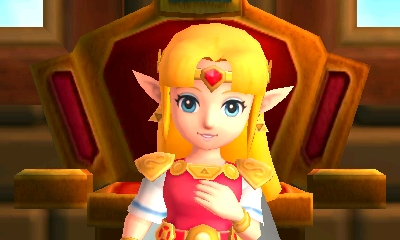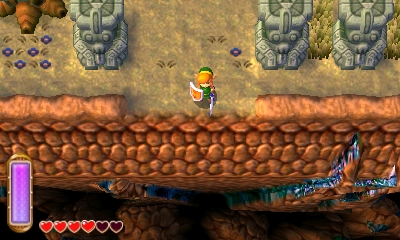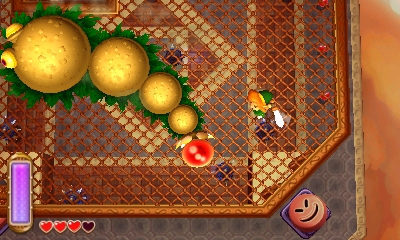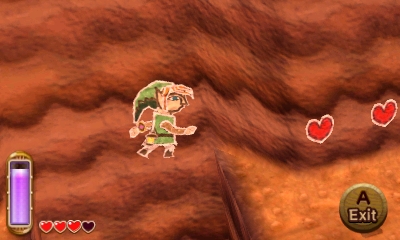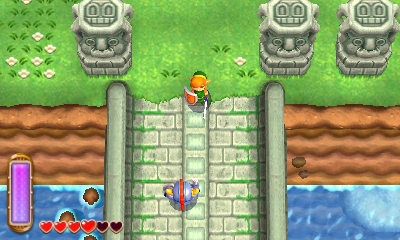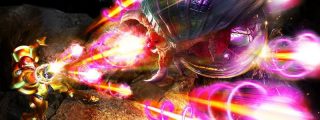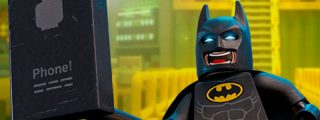Nostalgia is a hell of a drug, and at least for me nothing is more of a blast to the past than a Nintendo game that captures those gameplay elements and aesthetics that made me giddy as a young’un. A Link Between Worlds is a little more than just a new entry in the sword swingin’, dungeon crawlin’ Zelda franchise. It’s a throwback, a follow-up to A Link to the Past for the Super Nintendo. While I’m a bit of a heathen that sticks to calling Ocarina of Time the best of the best there is no doubt that inserting that little 3DS card into my handheld and turning it on instantly flooded back memories of the 16 bit days of yonder when Michael Jackson was still black and no one knew what a Starbucks was.
A Link Between Worlds nails down ALttP’s gameplay and world map to a T, the soundtrack is full of remastered versions of Past’s original music that had me giggling like I was nine years old again. Even the story hits all the same beats as Past, yet throws in some new twists, new faces, and includes in some plot elements and strong nods to other titles in the series such as Ocarina and Majora’s Mask. It all mixes together in a nice little pot luck dinner that’s guaranteed to fill any long time Zelda fan. So on the basis of Nostalgia it stands up there with video games that tickle your weak spot for the old school, games like Contra, Mega Man 9, Final Fantasy Warriors of Light and New Super Mario Bros.
But how does it stand on its own? Incredibly well. The game is technically impressive, and feels like one of the first titles to effectively make use of the 3DS’ largest features. A Link Between Worlds is pleasing on the eyes, the world is colorful and vibrant, characters and enemy models are smooth, the game also runs some great mileage out of the handheld’s stereoscopic 3D. Questing on the world map and traversing dungeons will often have Link maneuvering between high and low platforms, or diving under water, with Link growing larger or smaller as he gets closer or further away from the screen. With other 3DS games I find myself often turning the 3D effect down or up, as my eyes strain against the graphics or I just grow tired with the novelty 3D, since starting my “Between Worlds” adventure I haven’t turned it off once.
Not to forget the dual screens and stylus, the bottom screen is reserved for your world map and inventory, allowing you to quickly switch between weapons and place “pins” on important locations you find around the map. I’ve found both functions incredibly useful, if I ever came across a heart container I couldn’t reach or a cave I couldn’t yet access I would drop a pin on the location to remind me to come back later. Not having to stop the gameplay to climb into a menu screen and equip gear has also been a boon. It’s the first game to really impress me not just on its own, but with the handheld as a whole.
A Link Between Worlds comes with two new game mechanics of note. The first is Worlds’ “item rental” feature, the idea is that Ravio, a giant rabbit… person… thing… runs a Redbox(tm) type operation in which you can rent any item from him for a fee, this in turn lets you do dungeons in relatively any order you please. It’s a feature I initially scoffed at and, having now played the game, I’ve found has been implemented quite well. Tackling dungeons in any order means if a part of the world map currently stumps me I can go do something else, then come back at a later date. The game practically throws rupees at you, including a boss fight that literally showers you in cash, so Ravio’s rental fees are almost never a problem… the only caveat is if you fall in battle, Ravio will reclaim all the items he rented to you. This adds a little extra dimension to the gameplay, encouraging you to do well as if you die, you lose your inventory. For those of you saying “Well I don’t want to rent, I wanna own” you can do that too as the game progresses, for a hefty fee, though it’s also encouraged you start to buy your own items as doing so allows you to boost the power of each one via a sidequest.
The other major new mechanic is Link’s ability to merge into walls, becoming flat and 2D, and allowing him to slip through small cracks and thin openings. It’s a feature the game makes great use of in exploration, side quests, puzzles, dungeons, etc. A good rule of thumb is “When in doubt, merge into a wall.” The mechanic makes for some challenging and occasionally, intimidating puzzles and platforming. As far as Zelda games go, this is one of the more punishing ones, it may not be “Dark Souls” tough, but it does merge that old school Zelda gameplay with some new school sensibilities. Puzzles are going to require some good timing and fast reflexes, you can only stay merged into a wall until your magic bar depletes, and when that’s gone and if you happen to be over a pit when that happens…you can do the rest of that math. The mechanic is used in a variety of ways to put pressure on the player, I’d find myself slip through a crack in a dungeon only to see Hyrule far beneath my feet giving a sense of vertigo, or a stealth puzzle – usually the worst part of any Zelda game – that finally feels like a real puzzle thanks to my new-found ability.
It’s not just the wall merging that makes the game feel tough though, the game slams down a ton of enemies that at times you may just want to avoid instead of engage. Dungeons are also hard and somewhat unforgiving, even the first few “tutorial” dungeons let me know the gloves were off with this Zelda title. Yet the great thing is the difficulty never felt like “too much”, and there was never any instance where the game felt unfair, whenever I figured out the solution to any dungeon puzzle I frankly felt a little dumb for not figuring it out sooner. Despite the rental system and being able to get any item at any time, the game was very good about making sure one dungeon generally only required “one” item to complete as per Zelda tradition. Zelda games have erred on the side of easier in recent times, so it was nice to see a return to that harder difficulty, but it was also great it didn’t run aground of the other mistake Zelda titles often make, which is a poorly implemented mechanic making dungeons or puzzles harder than necessary…such as you know, stealth.
It’d be hard to sign off this review without talking about some of the smaller moments that made the game, such as the Majora mask on Link’s bedroom wall, or the thieves hideout that had me prison break a thief and served as a direct recall to ALttP’s Thieves Town, or the dungeon that made extensive use of manipulating light and shadow to find clues and solve puzzles. There are a few pretty neat mini games to be had as well, such as a baseball minigame that allows you to smash pots and collect rupees. New players to the series will also find a lot to like, it’s a great looking and sounding game, with a world and characters that are full of charm.
As a game I strongly recommend it and as a Zelda title, I greatly recommend it. You really can’t lose with this one, the game will give you some good mileage with its dungeons, gameplay, memorable cast and heck, even as far as Zelda storylines go this one manages to be fairly interesting. It’s the best use of the 3DS to date, and overall just a very solid and well made game. I’d go as far to say it could be a classic, but as with A Link to the Past, only the test of time will tell if that holds true.


